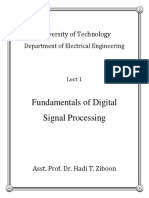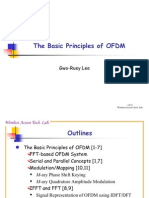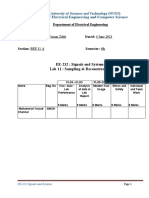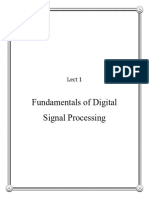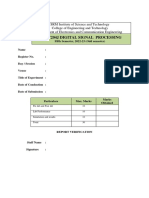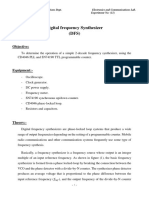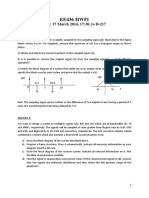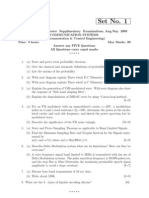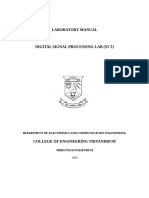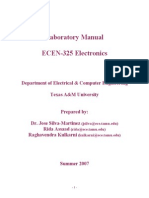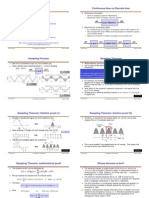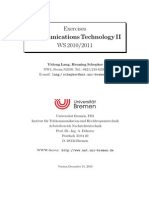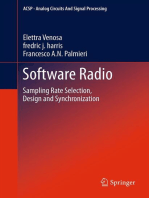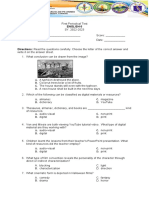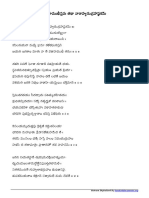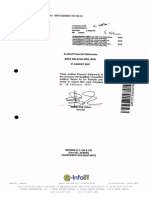Name:-Rahul Vora: Enroll No: - 92000103089
Name:-Rahul Vora: Enroll No: - 92000103089
Uploaded by
RAHUL VORACopyright:
Available Formats
Name:-Rahul Vora: Enroll No: - 92000103089
Name:-Rahul Vora: Enroll No: - 92000103089
Uploaded by
RAHUL VORAOriginal Description:
Original Title
Copyright
Available Formats
Share this document
Did you find this document useful?
Is this content inappropriate?
Copyright:
Available Formats
Name:-Rahul Vora: Enroll No: - 92000103089
Name:-Rahul Vora: Enroll No: - 92000103089
Uploaded by
RAHUL VORACopyright:
Available Formats
Department of Computer Engineering
Department of Information Technology
Name :- Rahul Vora
Enroll No :- 92000103089
Experiment No: 1 Pre Lab Exercise
Q-1 For the given information signal and train of pulse (of amplitude 1V). Draw sampled signal.
Hint: Use Multiplication principle of two signal.
(b)
Data Communication & Networking (01IT0301)
Department of Computer Engineering
Department of Information Technology
Q-3 What is Nyquist Criterion?
the Nyquist stability criterion is a criterion relating to the stability of control systems. It is widely
used in electronics and control systems engineering and in other fields. Although Nyquist's
condition is one of the most common stability tests, it is applicable only to linear systems invariant
with time. This test was invented by Swedish-American electrical engineer Harry Nyquist in 1932
at the Bell Telephone Laboratory.
Data Communication & Networking (01IT0301)
Department of Computer Engineering
Department of Information Technology
Identify relation between fs and fm for all three frequency spectrum.
(<,=, >) Comment effect of selection of fs in each case.
(a)fs>2fm
(b) fs = 2fm.
(c) fs<2fm
Data Communication & Networking (01IT0301)
Department of Computer Engineering
Department of Information Technology
Experiment 1: To perform sampling of a continuous signal and verify
Nyquist criteria for reconstruction of signal.
Apparatus: Scientech ST2101 trainer kit, DSO/CRO, connecting Probes, CRO Probes.
Theory:
The signals we use in the real world, such as our voice, are called "analog" signals. To
process these signals for digital communication, we need to convert analog signals to "digital"
form. While an analog signal is continuous in both time and amplitude, a digital signal is
discrete in both time and amplitude. To convert continuous time signal to discrete time signal,
a process is used called as sampling. The value of the signal is measured at certain intervals in
time. Each measurement is referred to as a sample. Consider an analogue signal x(t) that can be
viewed as a continuous function of time, as shown in figure1. We can represent this signal as a
discrete time signal by using values of x(t) at intervals of nTs to form x(nTs) as shown in figure
1. We are "grabbing" points from the function x(t) at regular intervals of time, Ts, called the
sampling period.
Figure 1. Basic Sampling Process
Figure 2 depicts the sampling of a signal at regular interval (period) t=nTs where n is an
integer. The sampling signal is a regular sequence of narrow pulses δ (t) of amplitude 1.Figure
3 shows the sampled output of narrow pulses δ (t) at regular interval of time.
Data Communication & Networking (01IT0301)
Department of Computer Engineering
Department of Information Technology
Figure 2. Sampling of signal at sampling interval (period) Ts
The time distance Ts is called sampling interval or sampling period, fs=1/Ts is called as
sampling frequency (Hz or samples/sec), also called sampling rate.
Figure 3. Sampled Output of narrow pulses δ (t)
Trainer Kit:
Data Communication & Networking (01IT0301)
Department of Computer Engineering
Department of Information Technology
Procedure:
Arrange all the equipment mentioned in the apparatus list.
Step-1 Basic Sampling and Reconstruction
1. Give 1 kHz analog input signal from t.p. 12 to the sampling circuit block at t.p. 34.
2. Choose the internal/external sampling frequency selector using control switch at t.p. 33
(In case of external sampling pulse input, give input signal on t.p. 31)
3. Observe the sampled output at sample amplifier t.p. 37 and ground by connecting CRO
probes.
4. Observe the sample and hold output at sample & hold amplifier t.p. 39 and ground by
connecting CRO probes.
5. Connect Sample signal to the second order filter block for observing reconstruction of
signal to the second order filter block at t.p. 40.
Data Communication & Networking (01IT0301)
Department of Computer Engineering
Department of Information Technology
6. Observe the output of reconstructed signal at output of filter block at t.p. 42
7. Repeat the steps 4-5 using fourth order filter block and observe the effect of order of the
filtering on reconstructed signal for various sampling rates at t.p. 46 by connecting CRO
probes.
Step-2 Sampling Rate Variation
8. Repeat the step-1 procedures 1-7 with different sampling rates like 20kHz, 40kHz, 80kHz,
160Khz and 320 kHz and by varying it using sampling frequency selector switch A36.
9. Observe the effect of various sampling rates on sampled signal and reconstructed signal
(both using second and fourth order filter).
Step-3 Duty Cycle Variation
10. Repeat the step-1 procedures 1-7 with different duty cycles of sampling signal by varying
selector switch A40 in duty cycle control circuit block.
11. Observe the effect of various duty cycle variation on sampled signal and reconstructed
signal (both using second and fourth order filter).
Waveforms: (paste your waveforms screenshot here)
Data Communication & Networking (01IT0301)
Department of Computer Engineering
Department of Information Technology
Multisim Simulation Circuit:
Procedure:
Connect the circuit as per the shown in figure above.
Step-1 Basic Sampling & Reconstruction
1. Set the signal source frequency 1KHz and sampler frequency 100KHz (Time period =
100us).
2. Set the pulse width of sampler 1 micro second.
3. Observe the sampled output of multiplier on CRO screen.
4. Now observe the reconstructed output of low pass filter at pin no. 6.
Step-2
Data Communication & Networking (01IT0301)
Department of Computer Engineering
Department of Information Technology
1. Now set the signal source frequency equal to last two digit of your enrollment number
(i.e. Enrollment No. 150570111020 then set frequency = 20Hz)
2. Consider the sampler frequency 10 times of your signal frequency (i.e. 20 Hz * 10 =
200 Hz). So set the time period of sampler = 1/f. (i.e. T = 0.005 Sec)
3. Set the Pulse width 1/10th of your time period (i.e. Width = 0.0005sec)
4. Observe the sampled output at multiplier.
5. Adjust the opamp filter frequency as per your signal frequency by changing the values of R
1
and C. (use formula f )
2 RC Conclusion:
Data Communication & Networking (01IT0301)
Department of Computer Engineering
Department of Information Technology
Experiment No :1 Post Lab Exercise
Q-1. Mark True/False for the given statement. Write corrected statement if you found
false.
(a) The basic purpose of sampling is to discretize the analog signal. True
(b) A band limited low pass signal is sampled at Nyquist rate with fs = 5000sps. The
signal is band limited to 2000Hz. True
(c) The basic Principal used to reconstruct the signal x(t) from x[n] is interpolation
True
Q-2. For a case study of sampling of audio song which consist several instruments along
with vocal frequency. Highest effective frequency component of instruments are
listed below. Consider composite signal is band limited signal.
Flute : 16 KHz Tabla : 800 Hz Vocal : 3.2 KHz
Congo : 600 Hz Guitar : 15 KHz
Considering above description match the following
1. Highest Frequency (B) A. 31.25 μs
2. Aliasing(C) B. 16 KHz
3. Low Pass Signal(D) C. Band Limited Signal
4. Nyquist Frequency(E) D.= 25 KHz
5. Nyquist Interval(A) E. 32 KHz
Q-3. Name the type of filtered used for reconstruction of signal. From your
observation, comment on reconstructed signal through various orders of
the filters.
1)Ideal Reconstruction
Data Communication & Networking (01IT0301)
Department of Computer Engineering
Department of Information Technology
Q-4. Determine Nyquist rate for the following signals.
(a) y(t) = 6 sin(200t)
Ws=2*200=400 rad/s.
Fs=Ws/s*π=63.70
(b) x(t) = 12 cos2(120πt)
x(t)=12(cos(240(πt)+1)/2
Fs=480/2π=240hz
Q-4. Determine the minimum Sampling frequency to be used to avoid sampling.
X(t) = 2.5 (2sin(100πt)*cos(400πt))
= 2.5(sin(500πt) – sin (300πt)) Wm
= 500π rad/s Ws= 1000π rad/s
Freq s= 500 H
Q-5. To explore interpolation three cases are given with sample instances. Just
mark sample point right side and join them with scale. Comment on
result for 1 sample per cycle, 2 sample per cycle and 3 sample per 2 cycle.
Data Communication & Networking (01IT0301)
Department of Computer Engineering
Department of Information Technology
Select the learing outcomes during your observation/performance of this experiment.
1. I have learn the role of Nyquist criteria into the reconstruction of sampled
signal.
2. I have calculated the requried bandwidth of digital output of continous
signal.
3. I have observed that 4th order Lowpass filter perform better than 2nd order
Lowpass filter interms of cross talk.
4. I have observed the effect of duty cycle of sampling signal on sampled and
reconstructed signals.
Data Communication & Networking (01IT0301)
You might also like
- Bashar: Blueprint For Change: A Message From Our Future: Click HereDocument5 pagesBashar: Blueprint For Change: A Message From Our Future: Click HereVictoria Rooker0% (2)
- Tutorial 4-SolutionDocument11 pagesTutorial 4-SolutionZaidi Mat ZainuddinNo ratings yet
- Communication Solved ProblemsDocument145 pagesCommunication Solved ProblemsAngel Linton50% (4)
- Group 5 - Manforce CondomsDocument27 pagesGroup 5 - Manforce CondomsFenny ShahNo ratings yet
- The Basic Principles of OFDMDocument30 pagesThe Basic Principles of OFDMsureshya22No ratings yet
- DSP LecturesDocument154 pagesDSP LecturesSanjeev GhanghashNo ratings yet
- Elec9123 DSP DesignDocument7 pagesElec9123 DSP DesignSydney FinestNo ratings yet
- The Basic Principles of OFDMDocument30 pagesThe Basic Principles of OFDMTippu SultanNo ratings yet
- Lab 11 - Muhammad Yousuf (306331)Document15 pagesLab 11 - Muhammad Yousuf (306331)Saif UllahNo ratings yet
- A FPGA Based TDEMI Measurement System For Quasi-Peak Detection and Disturbance AnalysisDocument4 pagesA FPGA Based TDEMI Measurement System For Quasi-Peak Detection and Disturbance AnalysisAli ShaebaniNo ratings yet
- Lecture Notes ٠٧٢٨٣٢Document154 pagesLecture Notes ٠٧٢٨٣٢العراق العظيمNo ratings yet
- Chapter 5Document22 pagesChapter 5kedirNo ratings yet
- TNE30003 Communication Principles: SamplingDocument41 pagesTNE30003 Communication Principles: SamplingTiến DũngNo ratings yet
- VI Sem ECE AssignmentsDocument11 pagesVI Sem ECE AssignmentsManoj VarmaNo ratings yet
- All Labs DSPDocument86 pagesAll Labs DSPM. Bilal Abbasi 32No ratings yet
- Solved Problems: EE160: Analog and Digital CommunicationsDocument145 pagesSolved Problems: EE160: Analog and Digital CommunicationsJoseSimoes100% (1)
- Exp-2 & 3-DSPDocument15 pagesExp-2 & 3-DSPSankalp SharmaNo ratings yet
- Introduction To Spread SpectrumDocument108 pagesIntroduction To Spread SpectrumBharath Prabhu PNo ratings yet
- Performance of Digital Communication LabDocument4 pagesPerformance of Digital Communication LabFrogie HuniebieNo ratings yet
- Elec3505 Exp1 2018-2Document6 pagesElec3505 Exp1 2018-2Sharmaine FernandoNo ratings yet
- DFS 11Document8 pagesDFS 11raymond wellNo ratings yet
- Chapter 4 - Digital Modulation & Transmission (Sem - 2 - 20152016) - V4Document104 pagesChapter 4 - Digital Modulation & Transmission (Sem - 2 - 20152016) - V4JamesNo ratings yet
- Cycle-1 ADC Manual - 18TEL67Document31 pagesCycle-1 ADC Manual - 18TEL67LitlatohNo ratings yet
- CT 111: Introduction To Communication Systems Lab 1: Figure 1Document2 pagesCT 111: Introduction To Communication Systems Lab 1: Figure 1Smit patelNo ratings yet
- DC Que BankDocument11 pagesDC Que BankGaurav Kumbharde0% (1)
- DSP Manual - 2017 VTU 2015 Cbcs SchemeDocument99 pagesDSP Manual - 2017 VTU 2015 Cbcs SchemeNikhil Miranda100% (1)
- Communication PDFDocument0 pagesCommunication PDFwww.bhawesh.com.npNo ratings yet
- Question BankDocument6 pagesQuestion Banksweetkhushboo786_592No ratings yet
- EE436 HW1 Spring2014Document2 pagesEE436 HW1 Spring2014techaddicttNo ratings yet
- Frequency Modulation & DemodulationDocument11 pagesFrequency Modulation & DemodulationALINo ratings yet
- Digital Signal Processing SamplingDocument66 pagesDigital Signal Processing Samplingsyazo93No ratings yet
- Digital Signal Processing LABDocument10 pagesDigital Signal Processing LABNimra NoorNo ratings yet
- DC ManualDocument62 pagesDC ManualnavecNo ratings yet
- Lab12Document16 pagesLab12contactdiyan2003No ratings yet
- rr322205 Communication SystemsDocument7 pagesrr322205 Communication SystemsSRINIVASA RAO GANTANo ratings yet
- 7 EC333 CompressedDocument81 pages7 EC333 CompressedRaushan kumarNo ratings yet
- School of Electronics Engineering: Specific Instruction To Students (If Any)Document2 pagesSchool of Electronics Engineering: Specific Instruction To Students (If Any)Dinesh ReddyNo ratings yet
- Problem Set 1Document4 pagesProblem Set 1Rushabh Mehta100% (1)
- DSP 394Document56 pagesDSP 394Muhammad Hashim raza100% (1)
- 07a Fourier AnalysisDocument20 pages07a Fourier AnalysisPersonOverTwoNo ratings yet
- ECEN325 Lab ManualDocument66 pagesECEN325 Lab ManualIrwan RamliNo ratings yet
- Sheet4 SolDocument4 pagesSheet4 SolNano GomeshNo ratings yet
- Lecture 13 - Sampling & Discrete SignalsDocument5 pagesLecture 13 - Sampling & Discrete SignalsSana SadafNo ratings yet
- Spread Spectrum Communications Using Chirp SignalsDocument5 pagesSpread Spectrum Communications Using Chirp SignalsArkaprava MajeeNo ratings yet
- Module-2 Baseband Transmission: Intersymbol InterferenceDocument22 pagesModule-2 Baseband Transmission: Intersymbol InterferencejayanthisreesNo ratings yet
- DSP 1Document4 pagesDSP 1Pavan KulkarniNo ratings yet
- Spread - Spectrum Modulation: Chapter-7Document22 pagesSpread - Spectrum Modulation: Chapter-7Deepika kNo ratings yet
- r05320201 Digital Signal ProcessingDocument8 pagesr05320201 Digital Signal ProcessingSri LalithaNo ratings yet
- Virtual Harmonic Analyser in LabVIEWDocument6 pagesVirtual Harmonic Analyser in LabVIEWBiljana RisteskaNo ratings yet
- LAB 1 BENG4711 Noise - PerformanceDocument4 pagesLAB 1 BENG4711 Noise - PerformanceDhamirah MirahNo ratings yet
- Indian Institute of Technology Roorkee: Department of Electronics and Communication EngineeringDocument2 pagesIndian Institute of Technology Roorkee: Department of Electronics and Communication EngineeringDalam MaharshiNo ratings yet
- CT ws10 enDocument23 pagesCT ws10 enIoana Suciu0% (1)
- OFDM For Optical CommunicationsDocument41 pagesOFDM For Optical CommunicationsPrasanna Kumar100% (1)
- Communication I1Document38 pagesCommunication I1Binod Pokhrel SharmaNo ratings yet
- Unit 1 Introduction To Digital Signal ProcessingDocument15 pagesUnit 1 Introduction To Digital Signal ProcessingPreetham SaigalNo ratings yet
- Effects of Sampling and Aliasing in Discrete Time SinusoidsDocument7 pagesEffects of Sampling and Aliasing in Discrete Time SinusoidsJuman RehmanNo ratings yet
- Ec 2004 (PDC) - CS - End - May - 2023Document24 pagesEc 2004 (PDC) - CS - End - May - 2023223UTKARSH TRIVEDINo ratings yet
- Fundamentals of Electronics 3: Discrete-time Signals and Systems, and Quantized Level SystemsFrom EverandFundamentals of Electronics 3: Discrete-time Signals and Systems, and Quantized Level SystemsNo ratings yet
- Software Radio: Sampling Rate Selection, Design and SynchronizationFrom EverandSoftware Radio: Sampling Rate Selection, Design and SynchronizationNo ratings yet
- Digital Signal Processing Using the ARM Cortex M4From EverandDigital Signal Processing Using the ARM Cortex M4Rating: 1 out of 5 stars1/5 (1)
- Analytical Modeling of Wireless Communication SystemsFrom EverandAnalytical Modeling of Wireless Communication SystemsNo ratings yet
- How To Make A Paper Maché Creation F NEW ZOODocument2 pagesHow To Make A Paper Maché Creation F NEW ZOOusama zedanNo ratings yet
- Owner's Manual: InformationDocument84 pagesOwner's Manual: InformationPabloNo ratings yet
- Brand Guideline PresentationDocument6 pagesBrand Guideline Presentationapi-520736120No ratings yet
- Inglés Mas MasDocument14 pagesInglés Mas MasAura ChanNo ratings yet
- English Grade 6Document10 pagesEnglish Grade 6lucille gayNo ratings yet
- Fun Wrestling - Reverse Schoolboy Pin (Chest Ride)Document10 pagesFun Wrestling - Reverse Schoolboy Pin (Chest Ride)xylon100% (5)
- Print New Media: BroadcastDocument29 pagesPrint New Media: BroadcastCatherine Concrenio0% (1)
- Data Spreadsheet For Animal Crossing (N64, GCN)Document851 pagesData Spreadsheet For Animal Crossing (N64, GCN)Sekar KusumaNo ratings yet
- Westlaw Academic Content 2014Document1,094 pagesWestlaw Academic Content 2014worksatyajeet0% (1)
- A Public Relations DisasterDocument3 pagesA Public Relations DisastervermaashleneNo ratings yet
- Detail Piling Pile Pondasi (Tiang Pancang) - ModelDocument1 pageDetail Piling Pile Pondasi (Tiang Pancang) - ModelFiszal OhoiwutunNo ratings yet
- Varahamuki-Stavam-Varahyanugraha-Ashtakam Telugu PDF File10427 PDFDocument3 pagesVarahamuki-Stavam-Varahyanugraha-Ashtakam Telugu PDF File10427 PDFNavaneetha PhaniNo ratings yet
- ArabesqueDocument13 pagesArabesqueFrederick NakosNo ratings yet
- Double FakeDocument15 pagesDouble FakeMárcia AntonioNo ratings yet
- ShowwriterresumeDocument2 pagesShowwriterresumeapi-712926939No ratings yet
- (Free Solution) Think of Examples in The Media That Poke Fun at The Communications Skills of Technical Professionals,..Document2 pages(Free Solution) Think of Examples in The Media That Poke Fun at The Communications Skills of Technical Professionals,..SAMINA ATTARINo ratings yet
- Functions of ARtsDocument7 pagesFunctions of ARtsLeaah DramayoNo ratings yet
- Yoru Ni Kakeru - Racing Into The NightDocument8 pagesYoru Ni Kakeru - Racing Into The Nightdaniel carrillo correaNo ratings yet
- Adele - 21 Limited Edition CD-Rip 320kbps Bonus PRIME READMEDocument3 pagesAdele - 21 Limited Edition CD-Rip 320kbps Bonus PRIME READMEoirochaNo ratings yet
- Astra 1H/1Kr/1L/1M at 19.2°E - LyngsatDocument18 pagesAstra 1H/1Kr/1L/1M at 19.2°E - Lyngsatsma,No ratings yet
- Global Media CulturesDocument2 pagesGlobal Media CulturesMigz AcNo ratings yet
- CBDocument7 pagesCBDevesh Prasad MishraNo ratings yet
- Desa Selatan SDN BHD Financial Statement 2021Document33 pagesDesa Selatan SDN BHD Financial Statement 2021YuvarajNo ratings yet
- (English 6 Week 2 Lesson 3) - Visual MediaDocument41 pages(English 6 Week 2 Lesson 3) - Visual Mediajofel butronNo ratings yet
- Review New Exam 1 Adv2Document4 pagesReview New Exam 1 Adv2Juan DiegoNo ratings yet
- Isekai RPG 2Document2 pagesIsekai RPG 2Nikolaj Rosgaard0% (1)
- How To Convert Textures For Fallout 4 Using Substance PainterDocument13 pagesHow To Convert Textures For Fallout 4 Using Substance PainterДенис Марфонов100% (1)
- A DARK DAY FOR HINKLEY, J - ReviewDocument9 pagesA DARK DAY FOR HINKLEY, J - ReviewNerissa VillarojasNo ratings yet





